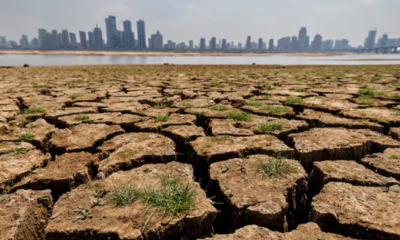Climate Change
Scorching heatwave in India’s Rajasthan kills nine

At least nine people have died of suspected heat stroke in India’s western state of Rajasthan, media said on Friday, with temperatures expected to soar further amid predictions of a severe heat wave.
Searing heat in the country’s north has been a cause of concern during a mammoth general election, and the capital, New Delhi, is set to vote on Saturday in temperatures forecast to be around 45 degrees C (113 degrees F), Reuters reported.
India’s summer temperatures often peak in May, but scientists have predicted more heatwave days than usual this year, largely caused by fewer non-monsoon thundershowers and an active but weakening El Nino weather phenomenon.
At least nine deaths in Rajasthan were suspected to have resulted from people falling sick in the sweltering heat, local media said.
The state’s disaster management officials told Reuters they had yet to ascertain the cause, as medical examinations were not complete.
The news comes after the city of Barmer in Rajasthan topped temperature charts this week with a record 48.8 C (119.84 F) on Thursday.
Weather officials have warned of conditions ranging from a heatwave to a severe heatwave in many parts of the state, as well as in the northern states of Punjab and Haryana.
Indian weather officials set the heatwave threshold at a maximum temperature of 40 C (104 F) in the country’s plains, as well as a departure of at least 4.5 C from the normal maximum temperature.
In the southern state of Kerala, by contrast, at least seven people died following pre-monsoon rains that were about 18% percent heavier than normal, bringing floods that disrupted flight schedules in some areas.
Climate Change
Flooding hits China’s south, temperatures sizzle elsewhere
Heavy rains have lashed southeastern Fujian province for seven days and are expected to continue, with water levels in some rivers exceeding warning levels. Authorities have released water from several reservoirs, China’s state television CCTV reported.

China’s National Meteorological Centre on Sunday issued an alert for high temperatures as multiple regions across the country experience sweltering heat, while many southern provinces issued severe flood warnings due to heavy rains.
The intensity of high temperatures is expected to decrease in north China and regions between the Yellow River and the Huaihe River, the centre said, Reuters reported.
The centre forecast maximum temperatures of 37-39 degrees Celsius (99-102 degrees Fahrenheit) in parts of Xinjiang, Inner Mongolia and Henan on Sunday.
Heavy rains have lashed southeastern Fujian province for seven days and are expected to continue, with water levels in some rivers exceeding warning levels. Authorities have released water from several reservoirs, China’s state television CCTV reported.
Authorities in Guangxi region said water levels of some local rivers had “skyrocketed” and that a student was killed in the floods in the southern city of Guilin, CCTV reported.
Climate Change
Heat wave kills at least 56 in India, nearly 25,000 heat stroke cases, from March-May

India saw nearly 25,000 cases of suspected heat stroke and 56 people lost their lives after several heat wave days across the country from March to May, local media reported, citing government data.
May has been a particularly bad month for the region, with temperature in capital Delhi and nearby state of Rajasthan touching 50 degrees Celsius, Reuters reported.
In contrast, parts of eastern India have been reeling under the impact of cyclone Remal. Heavy rain in the north eastern state of Assam has killed 14 people since Tuesday.
In the island nation of Sri Lanka, at least 15 people have died due to flooding and landslides after heavy monsoon rain lashed the region, the country’s Disaster Management Centre (DMC) said on Sunday.
A confluence of factors has led to a very hot summer in South Asia, a trend scientists say has been worsened by human-driven climate change.
At least 33 people, including election officials on duty in India’s just-concluded general election, died of suspected heatstroke in the states of Uttar Pradesh and Bihar in the north, and Odisha in the east on Friday.
Data from the National Centre of Disease Control (NCDC) showed that the situation was the worst in May, with 46 heat-related deaths and 19,189 suspected heat stroke cases, news website The Print reported.
Including suspected cases, the total number of deaths in India could be much higher at 80, newspaper The Hindu reported.
Over 5,000 cases of heatstroke were detected in the central state of Madhya Pradesh alone.
The weather office has predicted that heat wave conditions will be less severe till Wednesday and an early arrival of monsoon in the southern state of Kerala last week is expected to bring more relief.
Climate Change
Pakistan battles forest fires amidst heat wave

Authorities in Pakistan battled forest fires in multiple areas, including the capital Islamabad, on Friday as the country grappled with heat waves and dry weather.
Officials are yet to confirm if the fires are related to the high temperatures or due to arson.
Parts of Pakistan have seen temperatures as high as 52.2 degrees centigrade (126 F) over the last week with South Asia sweltering in a hotter summer this year – a trend scientists say has been worsened by human-driven climate change.
Plumes of smoke could be seen rising from a raging fire in the hills of Islamabad with temperatures hitting 41 degrees centigrade on Friday afternoon.
“It is difficult to get a fire brigade there; rescue officials are trying how to douse the fire,” a police official in Islamabad, Sohail Khan, told Reuters, adding that it was not certain if the fires were heat-related or cases of arson.
A spokesman for the Islamabad police said they were investigating the reasons for the fire and a special team had been formed for the probe by the city’s police chief.
A member of the Islamabad Wildlife Board, Waqar Zakaria, said the fire could be a case of “wilful arson”, adding that high temperatures have continued longer than usual and May has been drier than normal, leading to fires spreading faster because of dry vegetation.
An area in Punjab close to Islamabad, Kallar Kahar, also saw fire engulf 25 acres of grassland, the province’s disaster management (PDMA) said, adding that the flames, which had spread rapidly, had been contained.
“The Kalar Kahar forest fire might be a heat-related eruption,” PDMA spokesman Mazhar Hussain told Reuters.
Forest fires were also seen in Lower Dir, 250 km (155 miles) northwest of Islamabad, local resident Mohammad Jalil told Reuters by phone, adding that the flames had begun engulfing hundreds of trees four days ago and were yet to be controlled.
Pakistan is seen as by global organisations as one of the most vulnerable countries to extreme weather and climate change. In 2022, floods wreaked havoc in the country, killing over 1,700 people and displacing millions.
In India, at least 15 people died of suspected heat-stroke on Thursday with the region gripped by a debilitating heat wave expected to continue until Saturday.
(Reuters)
-

 Business4 days ago
Business4 days agoAfghan ministry of commerce meets with stakeholders to build a refinery
-

 Sport5 days ago
Sport5 days agoPakistan keep Super Eight hopes alive with seven-wicket win over Canada
-

 Latest News4 days ago
Latest News4 days agoPeshawar court summons officials over disappearance of 4 Afghan brothers
-

 Latest News4 days ago
Latest News4 days agoTürkiye sends in more humanitarian aid to Herat earthquake victims
-

 Latest News4 days ago
Latest News4 days agoIran Air starts flights to Kabul
-

 Latest News3 days ago
Latest News3 days agoAfghanistan’s central bank chief upbeat over stable AFN
-

 Latest News3 days ago
Latest News3 days agoUNICEF marks ‘sad’ 1,000-day milestone of ban on Afghan girls’ education
-

 Sport4 days ago
Sport4 days agoRankings joy for Afghanistan as Nabi crowned new No.1 all-rounder
























